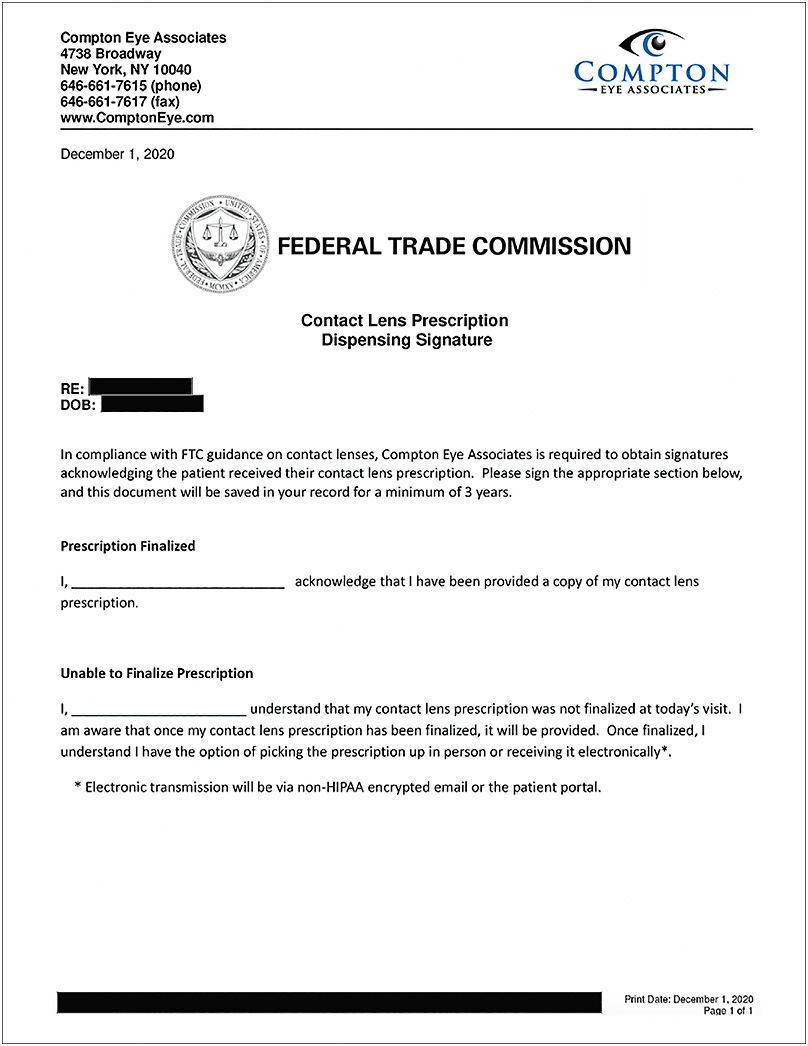
In February 2004, the Fairness to Contact Lens Consumers Act passed into law. Part of the act put certain responsibilities on prescribers. It also called on the U.S. Federal Trade Commission (FTC) to develop and enforce this new set of rules. In July 2004, the FTC released the ‘Contact Lens Rule,’ and on Oct. 16, 2020, it released amendments to the rule, which put certain responsibilities on us, as prescribers, and can cost $42,530 per violation. This article highlights what optometrists need to know about the rule.
Editor’s note: As this issue goes to press, here is the latest update on the new Contact Lens Rule: The Consolidated Appropriations Act, signed into law in the final days of 2020, directed the FTC to cease enforcement of the new rule until March 31, 2021 (see p.65 at bit.ly/359EvFi ). Also, see OM’s Jan. 6 online “O.D. Notebook” for a news item on the postponement.
As optometrists, we know the value of the doctor-patient relationship. We spend time understanding our patients’ visual and ocular demands, and, using that information, we make the appropriate recommendations.
With the new changes in place, we must take our examination a step further. We now are required to give the patient a copy of their contact lens prescription at the end of their exam, even if they do not ask for it.
Prescription confirmations from third parties have also been adjusted. We not only are required to provide a contact lens prescription to anyone who is designated to act on behalf of the patient, including contact lens sellers, but this verification must take place within a new timeline: Whereas there was no previous time constraint, now we have 40 business hours to comply. These requests could include fixes in inaccuracies in the prescription, informing the seller if the prescription is expired and providing a reason if the prescription is invalid. (Read more about requirements for sellers at “Final Rule for Sellers” p.18)
It is not enough that we provide the prescription. We must also make sure we obtain a signature from the patient acknowledging receipt of the prescription. After receiving that signature, we must keep it on file for no less than three years. Obtaining the signature can be done in numerous ways. Practices will have to figure out what works best for them.
Acceptable ways to document are as follows:
In situations in which a patient is unwilling to sign, we should document this, and make sure to keep that documentation for our records. This documentation also should contain our signature and the date of the patient interaction.
There are a few scenarios in which we may be exempt from this mandate. Specifically, the FTC indicates “doctors who do not have a direct or indirect financial interest in the sale of contact lenses do not need to request that a patient acknowledge receipt of a contact lens prescription and need not maintain records associated with patient acknowledgments.” Examples of this would include military, VA hospitals or Public Health Service on tribal reservations.

As we know, not every contact lens prescription is finalized at the initial date of service. Unfortunately, this does not relieve us of this new rule. To ensure we remain compliant, we have these options:
When sending emails, we must keep in mind another regulation, HIPAA. Remember, email communications containing health information are required to be sent securely or via encrypted email. If we do not have access to these options, that is OK, as the U.S. Department of Health and Human Services clarifies that, “covered entities are permitted to send individuals unencrypted emails if they have advised the individual of the risk, and the individual still prefers the unencrypted email.”
If we are going to be using non-HIPAA regulated email, it might be in our best interest to document that the patient understands the situation. A good place for this would be a patient intake form, according to the FTC. Patients could indicate on these forms how they would like to receive their contact lens prescription: On paper? Electronic? If electronic, non-HIPAA-regulated email or portal?
When prescribing GP, hybrid or even some specialty soft lenses, a lot goes into determining the final prescription. Unfortunately, The FTC clearly states there is not an exemption for these types of lenses. As noted in the initial rulemaking: “The Act thus does not permit the Commission by rule to grant an exception to the release requirement for custom-designed soft and rigid gas permeable lenses.”
This does make things a bit challenging because, whether fitting empirically or using diagnostic lenses, a lens needs to be ordered to finalize a prescription. The FTC clarifies that if a lens order is required to complete the fitting process, prescribers may charge for the lenses as part of the overall cost of the fitting process: ‘“Specialty” or custom-made lenses are sometimes necessary to complete the fitting process. To the extent these lenses are necessary to complete the fitting process, prescribers may charge patients for such lenses as part of the cost of the fitting process, and as such may condition the release of a contact lens prescription on payment of the fitting fee.”
While we must comply to this new mandate, the American Optometric Association (AOA) has fought and continues to fight on our behalf. Specifically, counter legislation called the Contact Lens Rule Modernization Act (S. 4613) has been introduced that would replace the signed patient acknowledgment with a requirement to post “conspicuous” signage in practices notifying patients of their right to a copy of their contact lens prescription, as is current law in California. (We can urge our representatives to co-sponsor the Contact Lens Rule Verification Modernization Act by visiting aoa.org/advocacy/federal/action-center .)

The final Contact Lens Rule includes several new requirements that address the seller’s prescription verification practices. According to the FTC website, the following action steps and definitions for sellers include:
→ Record the entire call and preserve the recording.
→ Start the call by identifying it as a prescription-verification request made in accordance with the Contact Lens Rule.
→ Deliver the verification message in a slow and deliberate manner and at a volume that the prescriber can understand.
→ Make the message repeatable at the prescriber’s request.
→ Make prominently available a way for consumers to present their prescriptions to the sellers, and clearly disclose that method.
→ Defines “alteration” of a prescription, which is prohibited, to include a brand or manufacturer other than what is prescribed to the consumer. This information must be provided as part of the verification process. The exception being if the consumer inputs information other than what is on the prescription.
→ Clarifies that the only permissible substitution involves private label lenses; private label and brand name lenses can be substituted when they are identical lenses by the same manufacturer.
This information is available via the FTC website, at bit.ly/3oiioE8 , and via the Federal Register at bit.ly/3hJ4N6u .
As stated by current AOA President William T. Reynolds, O.D.: “For nearly five years, we’ve fought together against the Federal Trade Commission’s baseless and costly contact lens paperwork and record-retention mandate, which unfairly targets us, our patients, practices, staff and communities.”
This is not over. OM
*Excerpts of this article appeared in the January issue of Contact Lens Spectrum.

DR. COMPTON owns two private practices, Compton Eye Associates in the New York City area. He is the president/founder of TheRightContact.com , a contact lens resource used by eye care professionals. He reports no financial disclosures.